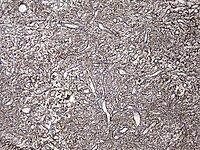Hemangiopericytoma

A hemangiopericytoma is a type of soft-tissue sarcoma that originates in the pericytes in the walls of capillaries. When inside the nervous system, although not strictly a meningioma tumor, it is a meningeal tumor with a special aggressive behavior. It was first characterized in 1942.
Histopathology
Hemangiopericytomas are tumors that are derived from specialized spindle shaped cells called pericytes, which line capillaries.
Diagnosis
Hemangiopericytoma located in the cerebral cavity is an aggressive tumor of the mesenchyme with oval nuclei with scant cytoplasm. "There is dense intercellular reticulin staining. Tumor cells can be fibroblastic, myxoid, or pericytic. These tumors, in contrast to meningiomas, do not stain with epithelial membrane antigen. They have a grade 2 or 3 biological behavior, and need to be distinguished from benign meningiomas because of their high rate of recurrence (68.2%) and metastases (Maier et al. 1992; Kleihues et al. 1993 )."
Treatment
Depending on the grade of the sarcoma, it is treated with surgery, chemotherapy, and/or radiotherapy.
Epidemiology
In one series, the median age of affected individuals was 45 years, with a 10 year survival rate of 70 percent.
See also
- Infantile hemangiopericytoma
- List of cutaneous conditions